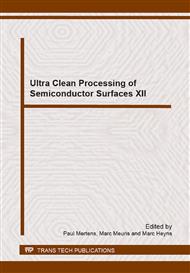p.161
p.165
p.170
p.177
p.183
p.187
p.193
p.197
p.201
Study of Etchants’ Diffusion into a 248 nm Deep UV Photoresist during a Wet Etch
Abstract:
Chemical etching is still preferred to plasma etching in numerous integrated circuits manufacturing steps. Indeed, it enables a better surface smoothness control, which is critical to obtain sufficient carrier mobility. During these steps, photoresist patterns protect underlying materials from etching. It is therefore mandatory to: 1) guarantee photoresist adhesion and keep patterns from being etched away; and 2) prevent surface degradation from etchants penetration down to the photoresist / material interface. To avoid this latter phenomenon, it is therefore crucial to know if etchants penetrate into the photoresist, and at which diffusion rate.
Info:
Periodical:
Pages:
183-186
Citation:
Online since:
September 2014
Authors:
Price:
Сopyright:
© 2015 Trans Tech Publications Ltd. All Rights Reserved
Share:
Citation:


